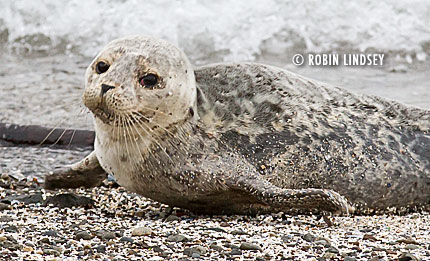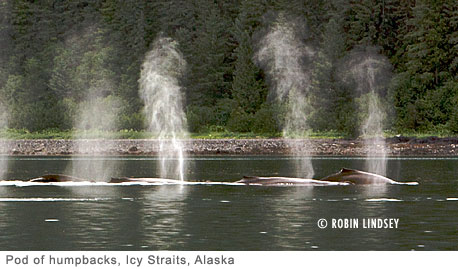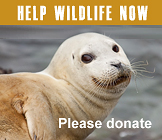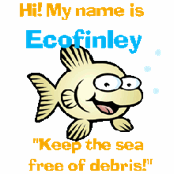Feb 2014
It takes a village to protect urban seal pups
Feb/26/14 06:02 AM

Early Saturday morning, Seal Sitters MMSN volunteers David and Eilene drove through the Don Armeni public boat launch on their way home from downtown Seattle. First responders, on and off duty, routinely look for pups in dangerous locations, such as the ramp, where pups often come ashore to rest. Sure enough, a pup was sleeping on the sand-covered cement, vulnerable not only to curious people, but much more worrisome, offleash dogs and boat traffic.
David quickly grabbed barricades and tape stashed at the location and established a perimeter to protect the pup in one of three lanes available for vessel launch and retrieval. Thankfully, in this boating off-season and cold rain, no boats were present.
Other first responders were on the scene in minutes to lend a hand. Scheduler for the day, Lynn J, was notified and she quickly referred to our online calendar and began calling volunteers. An iPhone was used to send out an APB “seal on the beach now” to all volunteers.
In 2-hour shifts, volunteers watched over the pup throughout the day in a cold, often drenching, rain. Nicknamed Penny (shown here moving closer to the sea wall, away from breaking waves), the thin pup showed no overt signs of illness, but lack of interest in people and nearby barking dogs was definitely a concern. A pup estimated to be anywhere from 6-8 months old should be much more wary of disturbance. However, there were no coughing spells or discharge from the nose or mouth - signs of parasite and viral load. Due to the physical constraints of the location with a parking lot and need to keep boat access open on the remaining ramps, the public was allowed closer than the ideal. The few boat owners that launched during the day were extremely cooperative and happy to give a resting pup some space.
Volunteers spoke with passersby who struggled to discern the shape of the pup on land even though they were just yards away. From the back, Penny looked like a dark rock. From the front, covered in sand and crushed shells, she blended into the shore. The spotted coat provides seals excellent camouflage from predators - or an inquisitive public. Dogs, however, with their keen sense of smell are easily able to seek out a pup - all the more reason to keep dogs leashed near beaches and well away from vulnerable young seals.
After dark, in the bitter cold 37 degree weather, volunteers continued to check on the pup during the night. Plans were put into place to capture the pup in the early morning hours for transport to rehab if the pup was still on shore. It is not unusual for a pup to spend well over 12 hours on shore, but something definitely seemed amiss for this increasingly listless pup. NOAA requests that no intervention occur until a pup has been onshore a minimum of 24 hours unless circumstances are unique - such as human interference - since there is a 50% mortality in the wild and there are extremely limited resources for rehabilitation in the Puget Sound region.
At high tide, around 1:30 am, Penny was no longer at the ramp. Volunteer Buzz located the pup at 2am, sleeping on the sand at nearby Duwamish Head, and put up a tape perimeter to prevent people from walking down the stairs to the beach. At 5:30 am, it was clear the pup was in distress and a first responder team assembled at 7am’s first light to capture the pup only a few feet from the approaching tide. The largely unresponsive pup was taken to PAWS Wildlife Center for stabilization and treatment, but died upon arrival.
If a necropsy is performed, we will share the results. Thanks to our many amazing volunteers who helped give Penny some peace on the beach. And thanks as always to PAWS’ caring staff. This is a very sad day for all of us.
NECROPSY RESULTS 2/26
PAWS Wildlife Center’s veterinarian performed a necropsy on Penny yesterday. The exam showed that the pup had pneumonia related to lungworm with what appears to be a sudden onset. The lack of obvious symptoms is somewhat baffling. The male pup weighed 14.7 kg. We are extremely grateful to PAWS.
Salmon recovery featured in Orca Talks series
Feb/25/14 05:46 AM
Salmon are the key to the recovery of the endangered southern resident orcas. How are the salmon populations of Puget Sound doing, and what can we do to help?
Jeanette Dorner of Puget Sound Partnership will discuss the current health of salmon populations in Puget Sound, what kinds of challenges salmon face, and what people are dong to help salmon recover in our waters.
One of a series of Orca Talks sponsored by The Whale Trail, the event features updates from Seal Sitters, Laura James of Tox-ick, and photography by Judy Lane. Please make sure to attend this fascinating evening.
Thursday, February 27, 2014
7-9pm
C&P Coffee Company, 5612 California Avenue SW
$5 suggested donation, kids free.
Tickets available brownpapertickets.com
Jeanette Dorner of Puget Sound Partnership will discuss the current health of salmon populations in Puget Sound, what kinds of challenges salmon face, and what people are dong to help salmon recover in our waters.
One of a series of Orca Talks sponsored by The Whale Trail, the event features updates from Seal Sitters, Laura James of Tox-ick, and photography by Judy Lane. Please make sure to attend this fascinating evening.
Thursday, February 27, 2014
7-9pm
C&P Coffee Company, 5612 California Avenue SW
$5 suggested donation, kids free.
Tickets available brownpapertickets.com
Marine mammals great and small in our area waters
Feb/17/14 07:55 AM
A report of a humpback whale off Lowman Beach was fielded by Seal Sitters’ hotline yesterday afternoon. West Seattle photographer and writer Judy Lane was out observing eagles when she noticed a humpback whale off shore, slapping the surface of the water with his or her massive tail (behavior known as a tail lob). Worried that the whale might be entangled near a buoy, Judy notified Donna Sandstrom of The Whale Trail (see Judy’s photos on their Facebook page) who quickly gave our stranding network a heads up that we had a whale in the area. The whale was last sighted around 2pm swimming freely and headed south near Lincoln Parks’ Pt. Williams. With high winds and choppy seas, a whale at a distance can be quite difficult to see without the telltale blow.
 Humpbacks are currently on the ESA endangered species list. Reaching lengths of up to 60 feet, females are larger than males. Through their baleen, they filter krill, plankton and other small crustaceans - up to 3,000 lbs a day. Newborn calves are about 15 feet in length, weighing around 1 ton and spend up to 10 months with mom.
Humpbacks are currently on the ESA endangered species list. Reaching lengths of up to 60 feet, females are larger than males. Through their baleen, they filter krill, plankton and other small crustaceans - up to 3,000 lbs a day. Newborn calves are about 15 feet in length, weighing around 1 ton and spend up to 10 months with mom.
Cascadia Research, based in Olympia, estimates that approximately 1,600 humpbacks feed off the Pacific Coast of North America, with 500 along the waters of Washington and British Columbia. An increasing number of mothers with calves have been sighted in Puget Sound and straits of the Pacific Northwest. A January sighting of a humpback in Puget Sound is unusual and could be of concern since most of the whales should be in Hawaii or Mexico this time of year. A humpback was also reported in Hood Canal last year in late January.
The annual migration of the humpback whale is the longest of any mammal on earth. Found in oceans all over the world, one typical migration from Alaska to Hawaii is over 3,000 miles, often completed in a little over a month. Swimming at the surface along the way, whales face grave dangers from marine debris, such as nets and crab pots. Watch a NOAA video here showing a whale disentanglement team freeing an entangled humpback - and learn how your vigilance and detailed reporting can help save whales from injury and death.
If you see a whale in Seattle’s Elliott Bay or the waters of Puget Sound near West Seattle, please report the sighting to Seal Sitters MMSN hotline @ 206-905-7325 (SEAL). As the marine mammal stranding network for this area, we like to be aware of any whales close to our shores. Photos of flukes and dorsal fins or dorsal bumps (gray whales) are extremely helpful not only for species identification, but also to identify individuals in the cetacean database kept by local researchers at Cascadia (1-800-747-7329) and Orca Network. If you are in a boat, please remember that whales are protected by the Marine Mammal Protection Act and stay back.
On Saturday, in a downpour, Seal Sitters volunteers watched over a much smaller visitor - a seemingly healthy seal yearling (born during last year’s pupping season) - resting and draped over the edge of an Elliott Bay rock. As the tide crept in and washed over his dangling rear flippers, he slipped off his perch into the gray, rain-splattered waters. Drenched first responders returned home to dry out.
Over the past few weeks, seal pups have made brief appearances on shore. Weaned and wiser at 5-8 months old, they are much more wary of people and dogs. The offshore rafts along Alki and Beach Drive have seen a fair amount of activity with resting pups.

Cascadia Research, based in Olympia, estimates that approximately 1,600 humpbacks feed off the Pacific Coast of North America, with 500 along the waters of Washington and British Columbia. An increasing number of mothers with calves have been sighted in Puget Sound and straits of the Pacific Northwest. A January sighting of a humpback in Puget Sound is unusual and could be of concern since most of the whales should be in Hawaii or Mexico this time of year. A humpback was also reported in Hood Canal last year in late January.
The annual migration of the humpback whale is the longest of any mammal on earth. Found in oceans all over the world, one typical migration from Alaska to Hawaii is over 3,000 miles, often completed in a little over a month. Swimming at the surface along the way, whales face grave dangers from marine debris, such as nets and crab pots. Watch a NOAA video here showing a whale disentanglement team freeing an entangled humpback - and learn how your vigilance and detailed reporting can help save whales from injury and death.
If you see a whale in Seattle’s Elliott Bay or the waters of Puget Sound near West Seattle, please report the sighting to Seal Sitters MMSN hotline @ 206-905-7325 (SEAL). As the marine mammal stranding network for this area, we like to be aware of any whales close to our shores. Photos of flukes and dorsal fins or dorsal bumps (gray whales) are extremely helpful not only for species identification, but also to identify individuals in the cetacean database kept by local researchers at Cascadia (1-800-747-7329) and Orca Network. If you are in a boat, please remember that whales are protected by the Marine Mammal Protection Act and stay back.
On Saturday, in a downpour, Seal Sitters volunteers watched over a much smaller visitor - a seemingly healthy seal yearling (born during last year’s pupping season) - resting and draped over the edge of an Elliott Bay rock. As the tide crept in and washed over his dangling rear flippers, he slipped off his perch into the gray, rain-splattered waters. Drenched first responders returned home to dry out.
Over the past few weeks, seal pups have made brief appearances on shore. Weaned and wiser at 5-8 months old, they are much more wary of people and dogs. The offshore rafts along Alki and Beach Drive have seen a fair amount of activity with resting pups.







